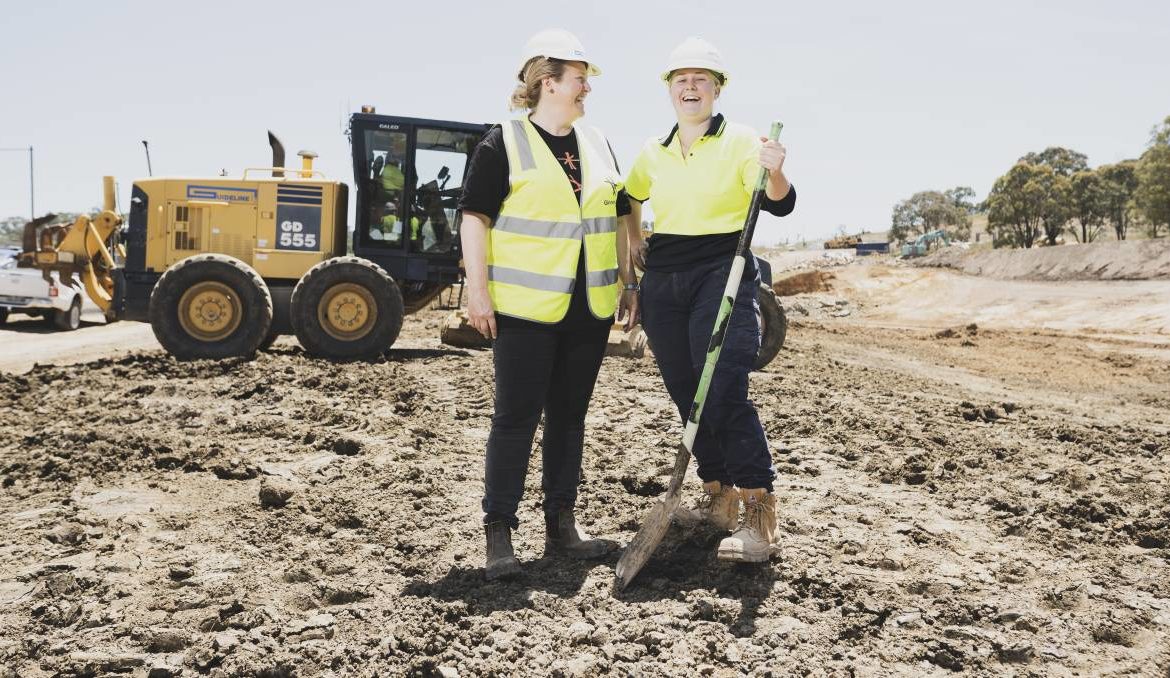news, latest-news, women in construction
Emma Sckrabei would like to see a world where a woman going into construction is not extraordinary, rather it’s a norm. It’s why she hopes a new program for high school students will attract more Canberra women to the trades. The Women in Construction Pathways Program will provide 40 school-based apprenticeships for ACT female students in years 10 and 11. The program has been started by the National Association of Women in Construction, alongside the Australian Training Company and the ACT government. Ms Sckrabei is NAIWC’s ACT education chair. She said the association was determined to introduce more women to the construction industry and this program would be one way to do so. “These young women are being given an opportunity to see, smell and taste what a career in construction could look like while at the same time working towards completing their secondary schooling,” she said. “It is these types of education and awareness programs that really make a difference in introducing more young women to the wonderful world of construction.” Students will be given the opportunity to try a variety of trades, including design, engineering, construction management, tiling and plastering. Participants rotate through the industries over a 10-to-12-week period. The program has already had a huge response. In the first intake earlier this year they were only supposed to have 20 apprentices but the program ended up accepting 22. Another 20 are set to take part in the program next year. The portion of women in construction trade-based roles is incredibly low. Ms Sckrabei said from a white-collar perspective the number of women in construction had improved, although it still had a long way to go, but female representation in blue-collar construction was dismal. She said figures had suggested women made up about 2 per cent of all blue-collar jobs but she thought in the ACT the number would be lower. “You can’t be what you can’t see,” Ms Sckrabei said. “We’re trying to get as many women as we can into the construction industry.” Ms Sckrabei said the program also sought to change perceptions about women in construction in the wider community. “It’s not just about getting women on the tools, it’s about educating the schools and parents and it shows there shouldn’t be anything unusual about women choosing construction pathways,” she said. “I hope one day a woman going into construction is not extraordinary, it just becomes the norm.” This sentiment was echoed by NAWIC ACT co-president Peita De Boer. “The first step of this journey is to normalise construction as a possible career path for young women, particularly high school students,” she said.
/images/transform/v1/crop/frm/fdcx/doc7ddlbr7gr3argkuocck.jpg/r72_411_4929_3155_w1200_h678_fmax.jpg
Emma Sckrabei would like to see a world where a woman going into construction is not extraordinary, rather it’s a norm.
It’s why she hopes a new program for high school students will attract more Canberra women to the trades.
The Women in Construction Pathways Program will provide 40 school-based apprenticeships for ACT female students in years 10 and 11.
The program has been started by the National Association of Women in Construction, alongside the Australian Training Company and the ACT government.
Ms Sckrabei is NAIWC’s ACT education chair. She said the association was determined to introduce more women to the construction industry and this program would be one way to do so.
“These young women are being given an opportunity to see, smell and taste what a career in construction could look like while at the same time working towards completing their secondary schooling,” she said.
“It is these types of education and awareness programs that really make a difference in introducing more young women to the wonderful world of construction.”
Students will be given the opportunity to try a variety of trades, including design, engineering, construction management, tiling and plastering.
Participants rotate through the industries over a 10-to-12-week period.
The program has already had a huge response. In the first intake earlier this year they were only supposed to have 20 apprentices but the program ended up accepting 22. Another 20 are set to take part in the program next year.
The portion of women in construction trade-based roles is incredibly low.
Ms Sckrabei said from a white-collar perspective the number of women in construction had improved, although it still had a long way to go, but female representation in blue-collar construction was dismal.
National Association of Women in Construction ACT chair Emma Sckrabei. Picture: Dion Georgopoulos
She said figures had suggested women made up about 2 per cent of all blue-collar jobs but she thought in the ACT the number would be lower.
“You can’t be what you can’t see,” Ms Sckrabei said.
“We’re trying to get as many women as we can into the construction industry.”
Ms Sckrabei said the program also sought to change perceptions about women in construction in the wider community.
“It’s not just about getting women on the tools, it’s about educating the schools and parents and it shows there shouldn’t be anything unusual about women choosing construction pathways,” she said.
“I hope one day a woman going into construction is not extraordinary, it just becomes the norm.”
This sentiment was echoed by NAWIC ACT co-president Peita De Boer.
“The first step of this journey is to normalise construction as a possible career path for young women, particularly high school students,” she said.







